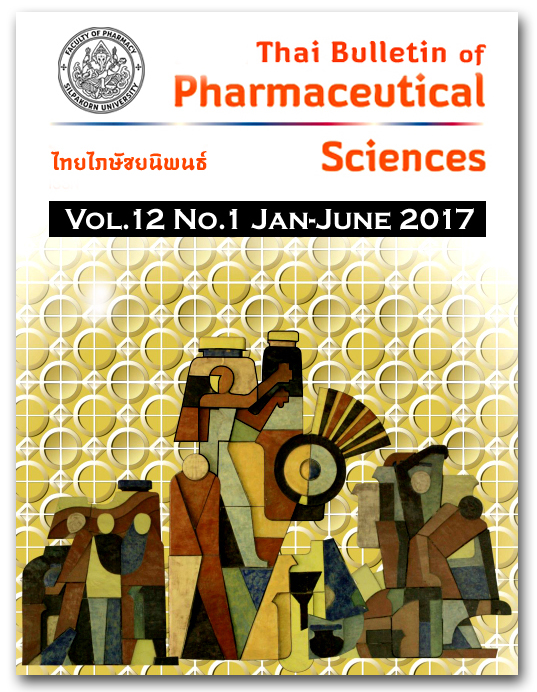ประโยชน์และความเสี่ยงของการใช้เมทฟอร์มินขนาดสูงบนพื้นฐานของหลักฐานเชิงประจักษ์ของการรักษาในปัจจุบัน (RISK-BENEFIT OF HIGH DOSE METFORMIN BEYOND CURRENT EVIDENCE BASED PHARMACOTHERAPY)
DOI:
https://doi.org/10.69598/tbps.12.1.55-62Abstract
เป้าหมายหลักของการรักษาโรคเบาหวานชนิดที่ 2 คือ การประสบผลสำเร็จในการควบคุมระดับน้ำตาลใน
กระแสเลือดให้ได้ผลตามระดับเป้าหมาย ลดอัตราการตาย และลดความเสี่ยงจากโรคแทรกซ้อนของหลอดเลือด
ขนาดเล็กและหลอดเลือดขนาดใหญ่ แนวทางการรักษาโรคเบาหวานชนิดที่ 2 ในปัจจุบันที่ให้คำแนะนำคือ
การปรับเปลี่ยนพฤติกรรมชีวิต เช่น การควบคุมอาหาร การออกกำลังกาย เป็นต้น ถ้าหากยังไม่สามารถควบคุมระดับน้ำตาลในเลือดได้ จะต้องให้การรักษาด้วยยาร่วมกับการปรับเปลี่ยนพฤติกรรมชีวิต โดยยาเมทฟอร์มินจะถูกใช้เป็นลำดับแรก ในการรักษาผู้ป่วยโรคเบาหวานชนิดที่ 2 หลายการศึกษาแนะนำการใช้ยาที่ปลอดภัยในขนาดต่าง ๆ ของยา
เมทฟอร์มินโดยขนาดการใช้ยาสูงสุดเท่ากับ 3,000 มิลลิกรัมต่อวันในรูปแบบยามาตรฐาน และขนาด 2,000 มิลลิกรัม
ต่อวันในรูปแบบยาออกฤทธิ์เนิ่น โดยนิยามของเมทฟอร์มินขนาดสูงคือมากกว่า 2,000 มิลลิกรัมต่อวัน ปัจจุบันมีหลักฐานการศึกษาต่าง ๆ เพิ่มมากขึ้นถึงประสิทธิภาพของการใช้ยาเมทฟอร์มินขนาดสูงในข้อบ่งใช้อื่น ๆ เช่น ลดความเสี่ยงโรคหัวใจและหลอดเลือด โรคถุงน้ำหลายใบในรังไข่ เป็นต้น ถึงแม้ว่าการใช้ยาเมทฟอร์มินอาจเกิดอาการข้างเคียงต่อระบบทางเดินอาหารและลำไส้ได้มากกว่าร้อยละ 20 แต่หลายการศึกษาพบว่าขนาดยาไม่ได้มีความสัมพันธ์กับอาการข้างเคียงและสามารถแก้ไขอาการเหล่านี้ได้ด้วยการปรับขนาดยาเพิ่มขึ้นอย่างช้า ๆ หรือรับประทานพร้อมมื้ออาหาร
ส่วนความเสี่ยงต่อการเกิดภาวะเลือดเป็นกรดแล็กติกพบได้น้อยมากเมื่อมีการใช้ยาที่ถูกต้องและไม่สัมพันธ์กับระดับยา
เมทฟอร์มินในกระแสเลือด ดังนั้นการเพิ่มประสิทธิภาพในการควบคุมระดับน้ำตาลในกระแสเลือดด้วยการเพิ่มขนาดใช้ยาเมทฟอร์มินและกลยุทธ์การรักษาในทางปฏิบัติขึ้นอยู่กับความเหมาะสมและการทนต่อยาของผู้ป่วยแต่ละรายเป็นสำคัญ
The primary goals of Type 2 Diabetes (Type 2 Diabetes mellitus, T2DM) treatment are to achieve glycemic control in therapeutic target, decrease mortality rate and risks of both microvascular and macrovascular complications. Current guideline of T2DM treatment recommended life style modification, such as, diet control, physical exercise, first. If patients still have uncontrolled blood glucose levels, metformin should be added. Although many studies suggested different safety dose of metformin for decreasing blood glucose level, its maximum dose is 3,000 and 2,000 mg/day for standard-release and extended-release, respectively. High dose of metformin definition is more than 2,000 mg/day. At present, there is increasing evidence from many studies about the efficacy of high dose metformin for other indications including decrease risk of cardiovascular diseases and, polycystic ovary syndrome. Although metformin may cause gastrointestinal side-effects in more than 20 percent of patient, many studies found that these side effects were not related to the dose and they could be managed by gradually increasing dose or administered with food. In addition, the risk of lactic acidosis is very rare if the medication is use appropriately, and it is not related to metformin blood level. Therefore, the reason of using metformin in various dose and treatment strategies for increasing efficacy in glycemic control depend on rational/appropriate indication and individual patients’ tolerability.
Downloads
Published
How to Cite
Issue
Section
License
All articles published and information contained in this journal such as text, graphics, logos and images is copyrighted by and proprietary to the Thai Bulletin of Pharmaceutical Sciences, and may not be reproduced in whole or in part by persons, organizations, or corporations other than the Thai Bulletin of Pharmaceutical Sciences and the authors without prior written permission.



